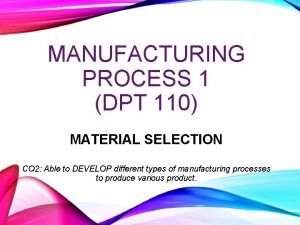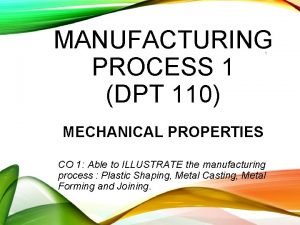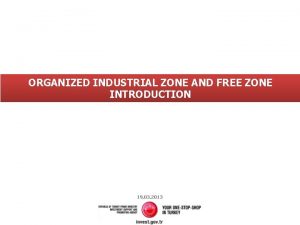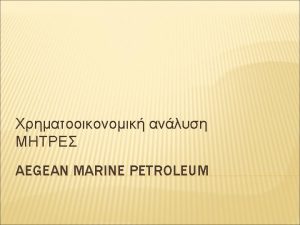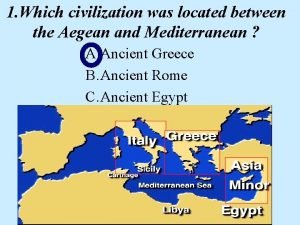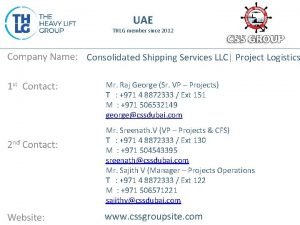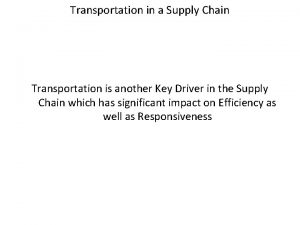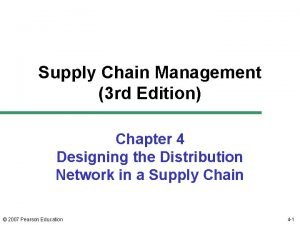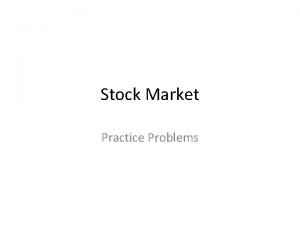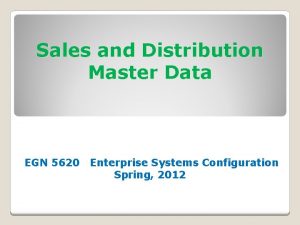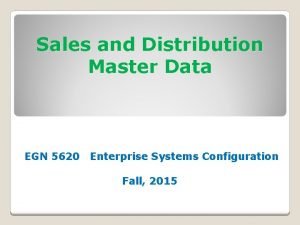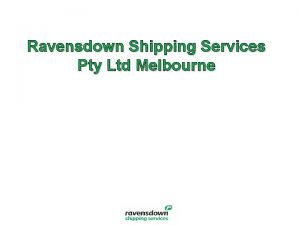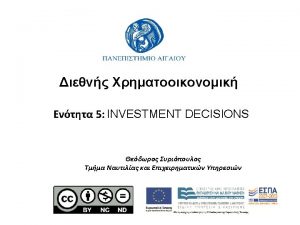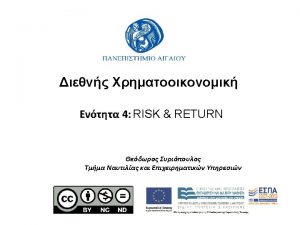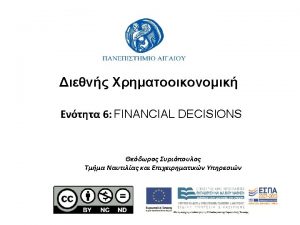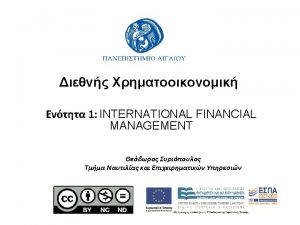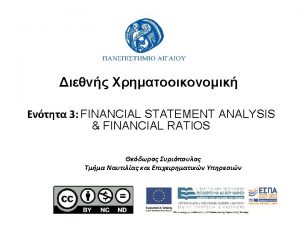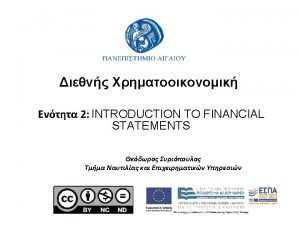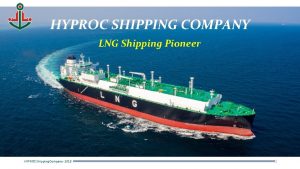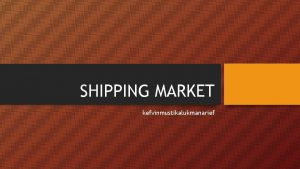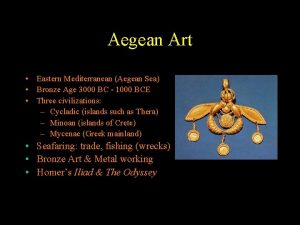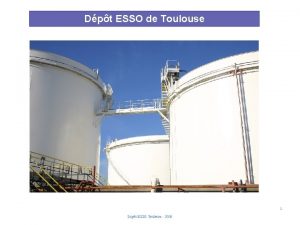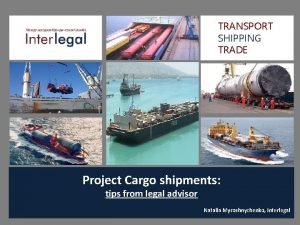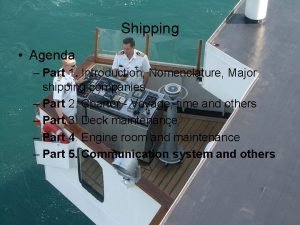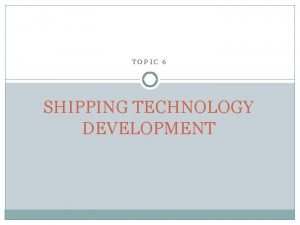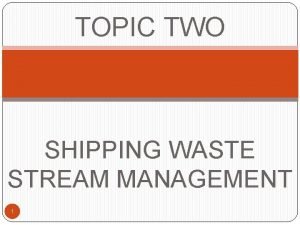UNIVERSITY OF THE AEGEAN Shipping Trade Transport Dpt

























































































- Slides: 89




UNIVERSITY OF THE AEGEAN Shipping, Trade & Transport Dpt. International Finance. INTFIN Professor Theodore SYRIOPOULOS

Course Overview 5

Guidelines § understand & become skilful in managerial decision-making with emphasis on corporate financial management § determine the financial resources to attain key corporate strategic objectives § increase the economic and social added value of the firm 6

Learning objectives § provide a consistent & integrated structure that ties all firm’s decisions together – from a theoretical & empirical perspective § the course - encourages you to think critically on core issues of corporate financial management; - helps you understand financial decision-taking; - enhances practical financial management expertise § to attain these goals, the course will cover material on: - Corporate Finance Tools - Financial Management & Value Creation - Investment Decisions - Financing Decisions - Business Decisions - Valuation 7

Core objective § to present & explain methods & tools that help managers undertake financial decisions that create value for the corporation 8


Support Bibliography Moles, P. , Parrino, R. & Kidwell, D. (2011): Fundamentals of Corporate Finance, J. Wiley Publications (ISBN: 9780470683705) Quiry, P. , Le Fur, Y. , Salvi, A. , Dallochio, M. , & Vernimmen, P. (2011, 3 rd ed. ): Corporate Finance: Theory and Practice, J. Wiley Publications (ISBN 9781119975588) Damodaran, A. (2009, 2 nd ed. ): Corporate Finance: Theory and Practice J. Wiley & Sons Inc. (ISBN 9780471283324) www. wiley. com/college/damodaran Berk, J. & De. Marzo, P. (2007): Corporate Finance Pearson International Edition (ISBN: 9780321416803) Brealey, R. , Myers, S. & Allen, F. (2007, 9 th ed. ): Principles of Corporate Finance Mc. Graw Hill Inc (ISBN 9780071266758) Brigham, E. F. & Ehrhardt, M. C. (2010 13 th ed. ): Financial Management: Theory and Practice South-Western Publications (ISBN 9780324422696) Damodaran, A. (2006, 2 nd ed. ): Valuation: Security Analysis for Investment and Corporate Finance J. Wiley & Sons Inc. (ISBN 9780471751212) Palepu, K. , Healy, P. & Bernard, V. (2007, 4 th ed. ): Business Analysis and Valuation: Using Financial Statements Southwestern Publications (ISBN 978 -0324302929) 10


Evaluation • continuous individual assessment 10% • class case study 20% • final exam (written) 70% 12

Corporate Finance Objectives: An Overview 13

Background n one of corporate financial management’s most useful guiding principles: • managers should manage firm resources with objective of… increasing the firm’s market value 14

Background § Key objectives: n management for value creation n how to measure value created by a business proposal, such as an investment project, a change in firm’s financial structure, a business acquisition, or decision to invest in a foreign country n the firm’s cost of capital & capital structure 15

Background n n Key objectives: n function of financial markets n determinants of firm’s business cycle n risk, returns, profitability as source of corporate funding Key input: financial statements (balance sheet, income statement, cash-flows) 16

17

10 Core Principles in Modern Corporate Finance 18

10 core principles in Modern Corporate Finance n P 1: the TIME-VALUE-OF-MONEY a dollar received today is worth more than a dollar received in the future 19

10 core principles in Modern Corporate Finance n P 2: the RISK – RETURN TRADE OFF we will not undertake additional risk unless we expect to be compensated with additional returns 20

10 core principles in Modern Corporate Finance n P 3: CASH – not profits – IS KING 21

10 core principles in Modern Corporate Finance n P 4: INCREMENTAL CASH FLOWS it’s only what changes that counts Incremental cash flows = difference between cash flows if project is taken on vs. cash flows if project is not taken on 22

10 core principles in Modern Corporate Finance n P 5: the curse of COMPETITIVE MARKETS why it is hard to find exceptionally profitable projects 23

10 core principles in Modern Corporate Finance n P 6: EFFICIENT CAPITAL MARKETS markets are quick and prices are right 24

10 core principles in Modern Corporate Finance n P 7: ALL RISKS ARE NOT EQUAL some risks can be diversified away and some cannot 25

10 core principles in Modern Corporate Finance n P 8: the AGENCY PROBLEM managers will not work for owners unless it is in their best interest 26

10 core principles in Modern Corporate Finance n P 9: TAXES BIAS in Business Decisions 27

10 core principles in Modern Corporate Finance n P 10: ETHICAL BEHAVIOR doing the right thing (dilemmas in finance) 28

Will your Decisions create Value ? 29

Financing an investment… § A project is financed by either: n shareholders provide equity capital n debt-holders provide debt capital 30

Risks vs. Returns… § Firm’s owners want to increase the firm’s value… a project’s expected return must exceed… …its financing cost ! 31

Investments & Value Creation… § before deciding to go ahead with a business proposal… …the manager should ask the Key Question: n will the proposal raise the firm’s market value? 32

Measuring Value Creation 33

Measuring Value Creation with Net Present Value (NPV) § Net Present Value concept or NPV n NPV = - Initial Cash Outlay + Future Net Cash Flows (present value of) 34

Measuring Value Creation with Net Present Value (NPV) n A business proposal creates value if: … § its Net Present Value >0 35

Discount Rates § to estimate NPV of investment, must… § § choose… for an investment, it is appropriate discount rate cost of financing this investment 36

Only Cash Matters to Investors investors are only interested in cash returns 37

Key Financial Decisions 38

Key Financial Decisions § impact of & implications for firm value of financial decisions on: § § capital budgeting capital structure business acquisition foreign investments 39

The Capital Budgeting Decision n n capital budgeting decisions affect firm’s business performance for a long period of time decision criteria in capital budgeting are direct applications of fundamental finance principle: • NPV rule • if NPVproject > 0 accept project • If NPVproject < 0 reject project • IRR rule (Internal Rate of Return) • if IRR > WACC accept project 40

Cost of Capital § when a project is funded with both equity & debt…. § cost of capital is …. weighted average cost of capital (WACC) • both shareholders & debt-holders require a return from their contribution 41

Cost of Financing a Business Project = WACC 42

The Capital Structure Decision § Firm’s optimal capital structure … n maximizes firm value WACC = lower possible firm market value = higher possible § As firm replaces equity with debt… n financial distress risk ensues (risk that firm may be unable to service its debt) 43

Optimal Capital Structure: greatest increase in cash flows from assets 44

The Business Acquisition Decision § acquisition of a business can increase firm value… § if only PV of future net cash flows from target firm exceed price paid for acquiring it • conglomerate merger • business to be acquired unrelated to firm’s current business • synergies • expected to raise sales or reduce costs beyond the sum of two firms’ pre-acquisition sales or costs 45

The Foreign Investment Decision § additional risks § currency risk • unanticipated changes in value of currency § political risk • unexpected events 46

The Role of Financial Markets 47

The Role of Financial Markets § role of financial markets in value creation… § primary markets • provide financing for funding growth • act as intermediaries § secondary markets • provide efficient means for trading outstanding securities § role of investment bankers 48

The dual functions of Financial Markets 49

The Equity Market § efficient equity markets… • share prices adjust instantly to new, relevant information • evidence indicates that on average most well-developed stock markets can be described as reasonably efficient equity markets (? ) 50

External vs. Internal financing § two ways to raise equity & debt capital… n external financing • short-term • money market • long-term • equity market • bond market n internal equity financing • retained earnings • companies retain their profits because regular access to external equity financing is often unavailable or is relatively expensive 51

The Business Cycle § profit-retention & business growth form concept of ‘business cycle’ that links a firm's: • debt-to-equity ratio • sales-to-asset ratio • net profit margin • retention rate 52

Business Cycle Dynamics Assumptions: - debt-to-equity ratio - sales-to-asset ratio - net profit margin - retention rate = 1 = 10% = 50% 53

The Business Cycle § the self-sustainable growth rate (SGR) defined as… • fastest SALES growth rate a firm can achieve by retaining a profit percentage & keeping unchanged both operating & financing policies • important indicator of business performance 54

Financial Accounting simplified 55

A simplified view of the Financial Accounting process 56

The Balance Sheet § Balance sheet shows: § what a firm’s shareholders own (assets) § what they owe (liabilities) • at a specific date 57

The Balance Sheet – traditional view 58

The Balance Sheet – financial view 59

Balance Sheet (standard) mln. USD FROM HLC’s STANDARD BALANCE SHEETS: ASSETS LIABILITIES AND OWNERS’ EQUITY DECEMBER 31 1999 Cash $100 $110 Accounts receivable 150 165 Inventories 250 Net fixed assets TOTAL DECEMBER 31 1999 DECEMBER 31 2000 Short-term borrowing DECEMBER 31 2000 $220 Accounts payable 100 110 275 Long-term debt 300 330 600 660 Owners’ equity 500 550 $1, 100 $1, 210 TOTAL Working Capital Requirement (WCR) = Accounts receivable + Inventories - Accounts payable 60

Managerial Balance Sheets mil. USD INVESTED CAPITAL OR NET ASSETS DECEMBER 31 1999 Cash Working Capital Requirement (WCR)1 Net fixed assets TOTAL 1 CAPITAL EMPLOYED DECEMBER 31 2000 DECEMBER 31 1999 DECEMBER 31 2000 $110 Short-term debt $200 $220 300 330 600 660 Long-term debt Owners’ equity 500 550 $1, 000 $1, 100 TOTAL Working Capital Requirement (WCR) = Accounts receivable + Inventories - Accounts payable 61

The Income Statement § purpose: • provide an estimate of change in book value of equity over a period of time • net profit vs. net loss • difference between: [revenues – expenses] 62

The Income Statement EBIT EAT 63

The Income Statement § EBIT can be related to its 3 categories of claimants • debt-holders (first claimants) • tax authorities (second claimants) • shareholders (residual claimants) 64

Income Statement mln USD Sales Less operating expenses (including depreciation expenses) $1, 000 ($760) Earnings before interest and tax (EBIT) Less interest expenses $240 (40) Earnings before tax (EBT) Less tax expenses Earnings after tax (EAT) $200 (100) $100 Retained earnings = $50 Dividend payment = $50 65

How much cash does a firm generate? § expected cash flows = key factor in deciding…. . n …whether a project will create or destroy value • measure cash flows generated by a firm’s activities on a continuous basis 66

How much cash does a firm generate? § a firm’s EBIT or EAT does NOT represent cash ! • need to know how much cash is behind EBIT & EAT 67

Sources & Uses of Cash § Sources of cash • Operations customers pay invoices • Investing firm sells assets • Financing firm borrows or issues new shares § Uses of cash • Operations pay its suppliers • Investing capital expenditures • Financing interest & dividend payments 68

Cash Flow Statement § summarizes a firm’s cash transactions • breaks them down into 3 main corporate activities: • Operations • Investments • Financing 69

Cash Flow Statement Firm’s cash position 70

Cash Flow Statement mln USD CASH FLOW FROM OPERATING ACTIVITIES Sales Less operating expenses (which include depreciation expenses) (760) Less tax expenses (100) Plus depreciation expenses Less cash used to finance the growth of WCR A. $1, 000 60 (30) NET OPERATING CASH FLOW $170 CASH FLOW FROM INVESTING ACTIVITIES Capital expenditures B. NET CASH FLOW FROM INVESTING ACTIVITIES (120) 71

Cash Flow Statement mln USD CASH FLOWS FROM FINANCING ACTIVITIES New borrowing 50 Interest payments (40) Dividend payments (50) C. NET CASH FLOW FROM FINANCING ACTIVITIES D. TOTAL NET CASH FLOW (A + B + C) (40) 10 E. CASH HELD AT BEGINNING OF YEAR $100 F. CASH HELD AT END OF YEAR (E + D) $110 72

Balance Sheet - Income Statement Link 2007 2008 73

Operating Cycle Impact on Balance Sheet = Change in the balance sheet account 74

Operating Cycle Cash-to-Cash Period operating cycle in terms of cash-to-cash period 75

How Profitable is a Firm? 76

How profitable is a firm? § information from a firm’s balance sheet & income statement can be combined… • …to analyze firm financial performance in terms of profitability…. . - of its equity - & its invested capital 77

Profitability of equity capital § a firm’s profitability to its shareholders is measured by owners’ return on investment: Return on Equity (ROE) 78

Profitability of invested capital § to measure profitability of total capital (provided by both shareholders + debt-holders)…. • Return on Invested Capital (ROIC): (same as Return on Capital Employed (ROCE)): 79

How Risky is a Firm? 80

How risky is a firm? § Firm SALES may fluctuate because of uncertainty in: - economic (micro – macro) - political - social - competitive environment • creates economic risk, magnified by fixed operating expenses produce operational risk 81

How risky is a firm? § economic risk + operating risk § magnified by fixed interest expenses financial risk § business risk + financial risk business risk firm’s total risk 82

How risky is a firm? § since… some operating expenses are fixed & some variable… uncertainty of SALES translates into… …Operating Profits more risky than Sales § because of interest expenses… risk increases further &… …Net Profits even more risky than Operating Profits… 83

Sensitivity evaluation Impact on EBIT, EBT, EAT of a + 10% in Sales mln USD Sales EXPECTE D SALES DOWN 10% SALES UP 10% $1, 000 $900 – 10% $1, 100 +10% Less variable operating expenses (380) (342) – 10% (418) +10% Less fixed operating expenses (380) same (380) EBIT (earnings before interest & tax) $240$178 Less fixed interest expenses (40) – 26% (40) $138 same – 31% $302 same +26% (40) same EBT (earnings before tax) $200 $262 +31% Less variable tax expenses (50%) (100) (69) – 31% (131) +31% EAT (earnings after tax) $100 $69 – 31% $131 +31% 84

Sources of Risk & Profit Volatility 85

Is then Value Created? 86

Is then Value Created? § fundamental principle of finance: § a firm is creating value if the NPV of all its investments > 0 87

Is then Value Created? § this should ultimately result to: § firm market value maximization that is i. e. increase of shareholder value reflected in upward share price movement 88

Criticism of Firm Value Max n max stock price not incompatible with employee needs/objectives in particular: • employees are often stockholders in many firms • firms that max stock price are firms treating employees well n max stock price does not mean that customers are not critical to success; in most businesses, keeping customers happy is the route to stock price max n max stock price does not imply that a firm has to be a social outlaw 89
 Tramp trade software
Tramp trade software Importance of ndt
Importance of ndt Dpt psychology
Dpt psychology Dpt 110
Dpt 110 Dpt 110
Dpt 110 Dpt psychology
Dpt psychology Sensible cooling on psychrometric chart
Sensible cooling on psychrometric chart Vcu dpt
Vcu dpt Aegean civilization
Aegean civilization Aegean peninsula
Aegean peninsula Aegean civilization
Aegean civilization Beach alliteration examples
Beach alliteration examples Led soldiers across hellespont into anatolia
Led soldiers across hellespont into anatolia Ancient greece peninsula
Ancient greece peninsula Nilufer organized industrial zone
Nilufer organized industrial zone Aegean marine petroleum network inc
Aegean marine petroleum network inc Toreador fresco meaning
Toreador fresco meaning Aegean dividend miles
Aegean dividend miles The earliest aegean civilization was located
The earliest aegean civilization was located Antiporter
Antiporter Primary active transport and secondary active transport
Primary active transport and secondary active transport Now answer the following questions
Now answer the following questions Active vs passive transport venn diagram
Active vs passive transport venn diagram Unlike passive transport, active transport requires *
Unlike passive transport, active transport requires * Primary active transport vs secondary active transport
Primary active transport vs secondary active transport Bioflix activity membrane transport active transport
Bioflix activity membrane transport active transport What is passive transport
What is passive transport Bioflix membrane transport
Bioflix membrane transport Trade diversion and trade creation
Trade diversion and trade creation Umich
Umich Trade diversion and trade creation
Trade diversion and trade creation The trade in the trade-to-gdp ratio
The trade in the trade-to-gdp ratio Fair trade not free trade
Fair trade not free trade Trade diversion and trade creation
Trade diversion and trade creation What was the triangular trade
What was the triangular trade Todor kableshkov university of transport
Todor kableshkov university of transport Pace university world trade center
Pace university world trade center Hình ảnh bộ gõ cơ thể búng tay
Hình ảnh bộ gõ cơ thể búng tay Slidetodoc
Slidetodoc Bổ thể
Bổ thể Tỉ lệ cơ thể trẻ em
Tỉ lệ cơ thể trẻ em Chó sói
Chó sói Tư thế worms-breton
Tư thế worms-breton Bài hát chúa yêu trần thế alleluia
Bài hát chúa yêu trần thế alleluia Môn thể thao bắt đầu bằng chữ f
Môn thể thao bắt đầu bằng chữ f Thế nào là hệ số cao nhất
Thế nào là hệ số cao nhất Các châu lục và đại dương trên thế giới
Các châu lục và đại dương trên thế giới Công thức tính độ biến thiên đông lượng
Công thức tính độ biến thiên đông lượng Trời xanh đây là của chúng ta thể thơ
Trời xanh đây là của chúng ta thể thơ Mật thư anh em như thể tay chân
Mật thư anh em như thể tay chân Làm thế nào để 102-1=99
Làm thế nào để 102-1=99 độ dài liên kết
độ dài liên kết Các châu lục và đại dương trên thế giới
Các châu lục và đại dương trên thế giới Thơ thất ngôn tứ tuyệt đường luật
Thơ thất ngôn tứ tuyệt đường luật Quá trình desamine hóa có thể tạo ra
Quá trình desamine hóa có thể tạo ra Một số thể thơ truyền thống
Một số thể thơ truyền thống Cái miệng bé xinh thế chỉ nói điều hay thôi
Cái miệng bé xinh thế chỉ nói điều hay thôi Vẽ hình chiếu vuông góc của vật thể sau
Vẽ hình chiếu vuông góc của vật thể sau Nguyên nhân của sự mỏi cơ sinh 8
Nguyên nhân của sự mỏi cơ sinh 8 đặc điểm cơ thể của người tối cổ
đặc điểm cơ thể của người tối cổ Thế nào là giọng cùng tên
Thế nào là giọng cùng tên Vẽ hình chiếu đứng bằng cạnh của vật thể
Vẽ hình chiếu đứng bằng cạnh của vật thể Tia chieu sa te
Tia chieu sa te Thẻ vin
Thẻ vin đại từ thay thế
đại từ thay thế điện thế nghỉ
điện thế nghỉ Tư thế ngồi viết
Tư thế ngồi viết Diễn thế sinh thái là
Diễn thế sinh thái là Dạng đột biến một nhiễm là
Dạng đột biến một nhiễm là Số.nguyên tố
Số.nguyên tố Tư thế ngồi viết
Tư thế ngồi viết Lời thề hippocrates
Lời thề hippocrates Thiếu nhi thế giới liên hoan
Thiếu nhi thế giới liên hoan ưu thế lai là gì
ưu thế lai là gì Khi nào hổ mẹ dạy hổ con săn mồi
Khi nào hổ mẹ dạy hổ con săn mồi Khi nào hổ con có thể sống độc lập
Khi nào hổ con có thể sống độc lập Hệ hô hấp
Hệ hô hấp Từ ngữ thể hiện lòng nhân hậu
Từ ngữ thể hiện lòng nhân hậu Thế nào là mạng điện lắp đặt kiểu nổi
Thế nào là mạng điện lắp đặt kiểu nổi Waterfront shipping company limited
Waterfront shipping company limited Consolidated shipping services
Consolidated shipping services Milk run vs cross docking
Milk run vs cross docking Factors influencing distribution network design
Factors influencing distribution network design June's portfolio includes 177 shares
June's portfolio includes 177 shares How to monitor log shipping in sql server 2005
How to monitor log shipping in sql server 2005 Shipping point determination
Shipping point determination Shipping point determination sap
Shipping point determination sap Proper shipping name
Proper shipping name Rcg manifest
Rcg manifest Ravensdown
Ravensdown



